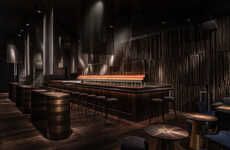
The Mott 32 Restaurant References Rich Cultural History
Vasiliki Marapas — October 3, 2014 — Lifestyle
Hong Kong architect Joyce Wang designed the interior for Mott 32 Restaurant, a design which has earned the title of 'World Interior of the Year' at the Inside Festival in Singapore. It beat out eight other competitors in the category.
The converted storage facility is a mixture of industrial aesthetic and colonial furnishings, creating an interesting visual juxtaposition. To introduce light into the space, the architect installed skylights. Other decorative details make historical references; such as the suspended metal chains, which allude to the city's fishing industry.
The interior has been broken up into a series of zones, each of which feature a distinctive, yet cohesive, design. For instance, a area designated for couples features a romantic silk-embroidered wall and apothecary-style bar.
The converted storage facility is a mixture of industrial aesthetic and colonial furnishings, creating an interesting visual juxtaposition. To introduce light into the space, the architect installed skylights. Other decorative details make historical references; such as the suspended metal chains, which allude to the city's fishing industry.
The interior has been broken up into a series of zones, each of which feature a distinctive, yet cohesive, design. For instance, a area designated for couples features a romantic silk-embroidered wall and apothecary-style bar.
Trend Themes
1. Industrial-chic Restaurants - Interior designers are creating unique, historically-inspired spaces for dining with both industrial touches and more traditional ones, often influenced by local industries and histories.
2. Multi-functional Design - Designers are incorporating several distinct zones or experiences, such as different seating areas and bars, into a single cohesive space to create a more engaging and personalized dining experience.
3. Cultural Referencing Spaces - Designers are incorporating local or cultural historical elements into their designs in order to create a heightened sense of place and context, as well as a unique draw for customers.
Industry Implications
1. Restaurant Industry - Restaurants can set themselves apart from competitors by creating unique and engaging spaces where customers can have a culturally-rich and personalized dining experience.
2. Interior Design Industry - Designers can create more meaningful and innovative spaces by incorporating cultural and industry influences into their interior design concepts.
3. Tourism and Hospitality Industry - Hotels and other tourism venues can create unique experiences for customers by incorporating local cultural and industry elements into their interior designs, and promote stronger connections with the places in which they operate.
4.8
Score
Popularity
Activity
Freshness























